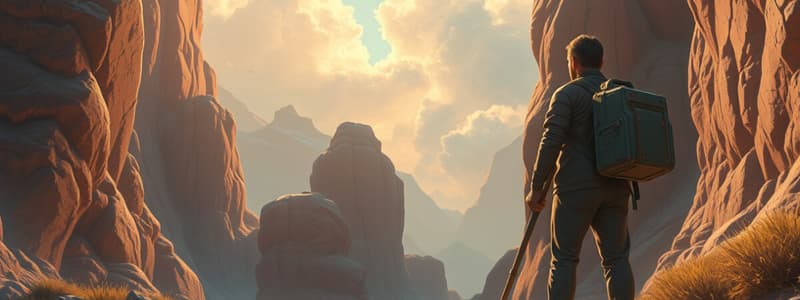Podcast
Questions and Answers
What is an Aerial Shot?
What is an Aerial Shot?
- An exterior shot from high above used to establish a location. (correct)
- A shot where the camera location is below normal eye-level.
- A shot in which the subject is circled by the camera.
- A shot that shows a particular part of a subject with more detail.
What is an Arc Shot?
What is an Arc Shot?
A shot in which the subject is circled by the camera.
What does a Bridging Shot do?
What does a Bridging Shot do?
It covers a break in time or other continuity breaks.
Define a Close Up Shot.
Define a Close Up Shot.
What characterizes a Medium Shot?
What characterizes a Medium Shot?
What is a Long Shot?
What is a Long Shot?
Describe a Cowboy Shot.
Describe a Cowboy Shot.
What is Deep Focus?
What is Deep Focus?
Explain a Dolly Zoom.
Explain a Dolly Zoom.
What is a Dutch Tilt?
What is a Dutch Tilt?
Define an Establishing Shot.
Define an Establishing Shot.
What is a Handheld Shot?
What is a Handheld Shot?
What is a Low Angle Shot?
What is a Low Angle Shot?
Define a High Angle Shot.
Define a High Angle Shot.
What is a Locked-Down Shot?
What is a Locked-Down Shot?
Explain a Library Shot.
Explain a Library Shot.
What is a Matte Shot?
What is a Matte Shot?
Define a Money Shot.
Define a Money Shot.
What is an Over-The-Shoulder Shot?
What is an Over-The-Shoulder Shot?
Describe a Pan Shot.
Describe a Pan Shot.
What is a POV Shot?
What is a POV Shot?
Define a Sequence Shot.
Define a Sequence Shot.
What is a Steadicam Shot?
What is a Steadicam Shot?
Describe a Tilt Shot.
Describe a Tilt Shot.
What is a Top Shot?
What is a Top Shot?
Define a Tracking Shot.
Define a Tracking Shot.
What is a Two-Shot?
What is a Two-Shot?
Describe a Whip Pan.
Describe a Whip Pan.
What is a Zoom Shot?
What is a Zoom Shot?
Define a Crane Shot.
Define a Crane Shot.
Flashcards
Aerial Shot
Aerial Shot
A shot captured from a high vantage point using cranes or helicopters, often used to establish exotic locations.
Arc Shot
Arc Shot
Involves the camera circling around the subject, creating a dynamic perspective.
Bridging Shot
Bridging Shot
Covers transitions in time or continuity, such as animating a moving line on a map.
Close Up Shot
Close Up Shot
Signup and view all the flashcards
Medium Shot
Medium Shot
Signup and view all the flashcards
Long Shot
Long Shot
Signup and view all the flashcards
Cowboy Shot
Cowboy Shot
Signup and view all the flashcards
Deep Focus
Deep Focus
Signup and view all the flashcards
Dolly Zoom
Dolly Zoom
Signup and view all the flashcards
Dutch Tilt
Dutch Tilt
Signup and view all the flashcards
Establishing Shot
Establishing Shot
Signup and view all the flashcards
Handheld Shot
Handheld Shot
Signup and view all the flashcards
Low Angle Shot
Low Angle Shot
Signup and view all the flashcards
High Angle Shot
High Angle Shot
Signup and view all the flashcards
Locked-Down Shot
Locked-Down Shot
Signup and view all the flashcards
Library Shot
Library Shot
Signup and view all the flashcards
Matte Shot
Matte Shot
Signup and view all the flashcards
Money Shot
Money Shot
Signup and view all the flashcards
Over-The-Shoulder Shot
Over-The-Shoulder Shot
Signup and view all the flashcards
Pan Shot
Pan Shot
Signup and view all the flashcards
POV Shot
POV Shot
Signup and view all the flashcards
Sequence Shot
Sequence Shot
Signup and view all the flashcards
Steadicam Shot
Steadicam Shot
Signup and view all the flashcards
Tilt Shot
Tilt Shot
Signup and view all the flashcards
Top Shot
Top Shot
Signup and view all the flashcards
Tracking Shot
Tracking Shot
Signup and view all the flashcards
Two-Shot
Two-Shot
Signup and view all the flashcards
Whip Pan
Whip Pan
Signup and view all the flashcards
Zoom Shot
Zoom Shot
Signup and view all the flashcards
Crane Shot
Crane Shot
Signup and view all the flashcards
Study Notes
Camera Shots and Angles
- Aerial Shot: Captured from a high vantage point using cranes or helicopters, often used to establish exotic locations.
- Arc Shot: Involves the camera circling around the subject, creating a dynamic perspective.
- Bridging Shot: Covers transitions in time or continuity, such as animating a moving line on a map.
- Close Up Shot: Focuses closely on a specific detail, like a subject's face, highlighting emotional expressions.
- Medium Shot: Frames the subject from the waist or knees up, balancing context with detail.
- Long Shot: Showcases the full body of the subject along with their environment, providing spatial context.
- Cowboy Shot: Frames the subject from mid-thigh up; commonly used in Western films to enhance character presence.
- Deep Focus: Maintains sharp focus across foreground, middle ground, and background, enhancing depth in scenes.
- Dolly Zoom: Simultaneously moves the camera closer to or further from the subject while adjusting zoom, creating a striking visual effect.
- Dutch Tilt: Involves tilting the camera to a diagonal angle to evoke a sense of disorientation.
- Establishing Shot: Provides an overview of the spatial relationships within a scene, typically from a distance.
- Handheld Shot: Shot with a moving camera to create a raw, documentary-style feel, often shaky.
- Low Angle Shot: Captured from below eye level, making subjects appear powerful or intimidating.
- High Angle Shot: Taken from above eye level, making subjects appear weak or vulnerable.
- Locked-Down Shot: Camera remains static while action unfolds outside its frame.
- Library Shot: A pre-existing footage of a location, indicating a low-budget or older production.
- Matte Shot: Combines foreground action with a digitally created or traditionally painted background.
- Money Shot: High-cost shot that aims to captivate the audience, often visually striking.
- Over-The-Shoulder Shot: Captures the perspective from behind a subject, emphasizing connections during conversations.
- Pan Shot: Involves horizontal movement of the camera around a fixed axis to transition between different areas of a scene.
- POV Shot: Presents the scene from a character's visual perspective, immersing viewers in their experience.
- Sequence Shot: A continuous, unedited shot that captures the complete scene, providing an uninterrupted narrative.
- Steadicam Shot: Provides smooth camera movement, enhancing fluidity in scenes without the shakiness of handheld shots.
- Tilt Shot: Involves vertical movement of the camera, capturing action or emotion.
- Top Shot: Offers a direct overhead view of a scene, also known as Bird's-Eye-View, enhancing spatial relationships.
- Tracking Shot: Follows a moving subject parallel to its path, more refined than panning and elegant in execution.
- Two-Shot: A medium shot featuring two characters, useful for establishing relationships and interactions.
- Whip Pan: Fast side-to-side camera movement creating a blur effect, used for dynamic transitions.
- Zoom Shot: Utilizes a variable focal length lens, allowing distance adjustment from the subject without moving the camera.
- Crane Shot: Involves vertical movement via a crane, often used to enhance emotional moments or signify farewells.
Studying That Suits You
Use AI to generate personalized quizzes and flashcards to suit your learning preferences.




